GENERAL INFORMATION
SIZE
Pluto is smaller than the 8 planets in our Solar System.
MASS AND GRAVITY
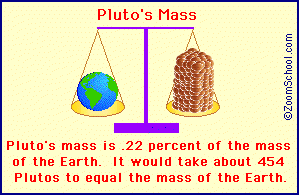 Pluto's mass is about 1.29 x 1022 kg. This is about 1/500th of the mass of the Earth. The gravity on Pluto is 8% of the gravity on Earth.
Pluto's mass is about 1.29 x 1022 kg. This is about 1/500th of the mass of the Earth. The gravity on Pluto is 8% of the gravity on Earth.
Pluto is the least massive planet in our Solar System (and is now classified as a dwarf planet).
A 100 pound person on Pluto would weigh only 8 pounds.
LENGTH OF A DAY AND YEAR ON PLUTO
 Each day on Pluto takes 6.39 Earth days. Each year on Pluto takes 247.7 Earth years (that is, it takes 247.7 Earth years for Pluto to orbit the Sun once).
Each day on Pluto takes 6.39 Earth days. Each year on Pluto takes 247.7 Earth years (that is, it takes 247.7 Earth years for Pluto to orbit the Sun once).
PLUTO'S ORBIT
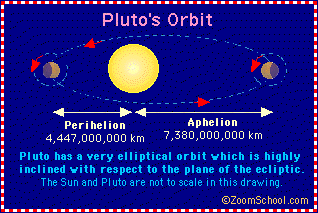 Pluto is 39 times farther from than the sun than the Earth is. Pluto ranges from 2.8 to 4.6 billion miles (4.447 billion to 7.38 billion km) from the Sun. From Pluto, the sun would look like a tiny dot in the sky.
Pluto is 39 times farther from than the sun than the Earth is. Pluto ranges from 2.8 to 4.6 billion miles (4.447 billion to 7.38 billion km) from the Sun. From Pluto, the sun would look like a tiny dot in the sky.
MASS AND GRAVITY
Pluto is the least massive planet in our Solar System (and is now classified as a dwarf planet).
A 100 pound person on Pluto would weigh only 8 pounds.
LENGTH OF A DAY AND YEAR ON PLUTO
PLUTO'S ORBIT
Occasionally, Neptune's orbit is actually outside that of Pluto; this is because of Pluto's highly eccentric (non-circular) orbit. During this time (20 years out of every 248 Earth years), Neptune is actually the farthest planet from the Sun (and not Pluto). From January 21, 1979 until February 11, 1999, Pluto was inside the orbit of Neptune. Now and until September 2226, Pluto is outside the orbit of Neptune.
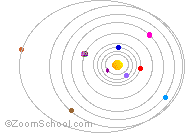 Orbital Eccentricity
Orbital Eccentricity
Pluto has a very eccentric orbit; that means that its distance from the sun varies a lot during its orbit around the sun. Sometimes it is even closer to the Sun than the planet Neptune (it was that way from January 1979 to February 11, 1999)! Pluto also rotates about its axis in the opposite direction from most of the other planets.
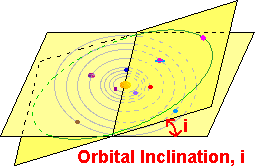 Orbital Inclination
Orbital Inclination
Pluto's orbit is tilted from the plane of the ecliptic. This angle, its orbital inclination, is 17.15°. This is a much larger inclination of those of the eight planets.
 TEMPERATURE ON PLUTO
TEMPERATURE ON PLUTO
Pluto is VERY, VERY cold. Its temperature may range from between -396°F to -378°F (-238°C to -228°C, or 35 K to 45 K). The average temperature is -393°F (-236°C = 37 K).
PLANETARY COMPOSITION
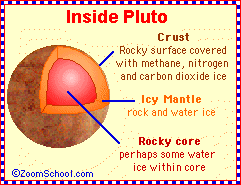 Pluto's composition is unknown. It is probably made up of about 70% rock and 30% water. This is determined from density calculations; Pluto's density is about 2,000 kg/m3. There may be methane ice together with frozen nitrogen and carbon dioxide on the cold, rocky surface.
Pluto's composition is unknown. It is probably made up of about 70% rock and 30% water. This is determined from density calculations; Pluto's density is about 2,000 kg/m3. There may be methane ice together with frozen nitrogen and carbon dioxide on the cold, rocky surface.
ATMOSPHERE
Not much is known about Pluto's atmosphere. It is probably mostly nitrogen with a little carbon monoxide and methane - definitely not breatheable by humans. The atmospheric pressure is probably very low. The atmosphere forms when Pluto is closest to the Sun and the frozen methane is vaporized by the solar heat. When it is farther from the Sun, the methane freezes again. From Pluto, the sky would appear black, even when the Sun (the size of a star) is up.
PLUTO'S MOONS
 Pluto has one large moon, named Charon; two minscule moons were discovered in 2005. The tiny moons are called.
Pluto has one large moon, named Charon; two minscule moons were discovered in 2005. The tiny moons are called.
Pluto has a very eccentric orbit; that means that its distance from the sun varies a lot during its orbit around the sun. Sometimes it is even closer to the Sun than the planet Neptune (it was that way from January 1979 to February 11, 1999)! Pluto also rotates about its axis in the opposite direction from most of the other planets.
Pluto's orbit is tilted from the plane of the ecliptic. This angle, its orbital inclination, is 17.15°. This is a much larger inclination of those of the eight planets.
Pluto is VERY, VERY cold. Its temperature may range from between -396°F to -378°F (-238°C to -228°C, or 35 K to 45 K). The average temperature is -393°F (-236°C = 37 K).
PLANETARY COMPOSITION
ATMOSPHERE
Not much is known about Pluto's atmosphere. It is probably mostly nitrogen with a little carbon monoxide and methane - definitely not breatheable by humans. The atmospheric pressure is probably very low. The atmosphere forms when Pluto is closest to the Sun and the frozen methane is vaporized by the solar heat. When it is farther from the Sun, the methane freezes again. From Pluto, the sky would appear black, even when the Sun (the size of a star) is up.
PLUTO'S MOONS
Although Charon is small, about 1,172 km (728 miles) in diameter, it about half of the size of Pluto itself. Charon orbits about 19,640 km from Pluto on average. It may be covered by water ice and probably has no atmosphere. Charon is in a synchronous orbit around Pluto. That is, Charon is always over the same spot on Pluto; Charon's orbit takes exactly one Pluto day.
Charon was discovered by Jim Christy in 1978. Charon was named after the mythological demon who ferried people across the mythological river Styx into Hades.
Charon was discovered by Jim Christy in 1978. Charon was named after the mythological demon who ferried people across the mythological river Styx into Hades.
The two tiny moons, Nix and Hydra, are from 30 and 100 miles (45 to 160 km) in diameter, and orbit Pluto about 27,000 miles (44,000 km) from Pluto, more than twice as far as the orbit of Charon.
DISCOVERY OF PLUTO
Pluto was discovered after the 8 planets and was originally considered a planet itself (until 2006). In the early 1900s, Planet "X" was the temporary name given to the then-unknown planet beyond Neptune that disturbed the orbits of Uranus and Neptune. Percival Lowell calculated the rough location of Planet "X's" orbit, but died in 1916 before it was found. This planet was eventually found by the American astronomer Clyde W. Tombaugh in 1930 and named Pluto. He did his observations at the Lowell Observatory in Arizona.
PLUTO-EARTH COMPARISON
DISCOVERY OF PLUTO
Pluto was discovered after the 8 planets and was originally considered a planet itself (until 2006). In the early 1900s, Planet "X" was the temporary name given to the then-unknown planet beyond Neptune that disturbed the orbits of Uranus and Neptune. Percival Lowell calculated the rough location of Planet "X's" orbit, but died in 1916 before it was found. This planet was eventually found by the American astronomer Clyde W. Tombaugh in 1930 and named Pluto. He did his observations at the Lowell Observatory in Arizona.
PLUTO-EARTH COMPARISON
PLUTO'S NAME
This is the symbol of Pluto. |
Its symbol is the combined letters "P" and "L," either for Percival Lowell or for Pluto.
The name Pluto was suggested by Venetia Burney of England, who was 11 years old at the time. She suggested the name to her grandfather, who was Librarian at Oxford. He passed her idea to the astronomers who were trying to name the newly-discovered planet.
PLUTO: PLANET, ASTEROID, OR TNO
Pluto's unusual orbit makes some scientists think that Pluto is not a regular planet, but a "dwarf planet," "minor planet" or a Trans Neptunian Object (TNO) [Kuiper Belt objects left over from the formation of the solar system]. In 2006 Pluto was re-classified as a dwarf planet. Alternatively, Pluto could have been be listed as an asteroid (it would have been given the asteroid number 10,000). It also may be the first TNO - it will also still be considered a dwarf planet.
PLUTO: PLANET, ASTEROID, OR TNO
Pluto's unusual orbit makes some scientists think that Pluto is not a regular planet, but a "dwarf planet," "minor planet" or a Trans Neptunian Object (TNO) [Kuiper Belt objects left over from the formation of the solar system]. In 2006 Pluto was re-classified as a dwarf planet. Alternatively, Pluto could have been be listed as an asteroid (it would have been given the asteroid number 10,000). It also may be the first TNO - it will also still be considered a dwarf planet.
Although Pluto was discovered in 1930, limited information on the distant object delayed a realistic understanding of its characteristics. Pluto is the second largest known dwarf planet and tenth largest orbiting the Sun. From its time of discovery in 1930 to 2006 it was considered to be the ninth planet in the solar system, but because additional objects have been discovered including Eris which is 27% more massive, the IAU reclassified Pluto and the other objects as dwarf planets. The New Horizons spacecraft was launched on January 16, 2006 and will make its closest approach to Pluto on July 14, 2015. This mission will provide an increased amount of information about this peculiar dwarf planet. The uniqueness of Pluto's orbit, rotational relationship with its satellite, spin axis, and light variations all give it a certain appeal.
Pluto is usually farther from the Sun than any of the eight planets; however, due to the eccentricity of its orbit, it is closer than Neptune for 20 years out of its 249 year orbit. Pluto crossed Neptune's orbit January 21, 1979, made its closest approach September 5, 1989, and remained within the orbit of Neptune until February 11, 1999. This will not occur again until September 2226.
As Pluto approaches perihelion it reaches its maximum distance from the ecliptic due to its 17-degree inclination. Thus, it is far above or below the plane of Neptune's orbit. Under these conditions, Pluto and Neptune will not collide and do not approach closer than 18 A.U. to one another.
Pluto's rotation period is 6.387 days, the same as its satellite Charon. Although it is common for a satellite to travel in a synchronous orbit with its planet, Pluto rotates synchronously with the orbit of its satellite. Thus being tidally locked, Pluto and Charon continuously face each other as they travel through space.
Unlike most planets, but similar to Uranus, Pluto rotates with its poles almost in its orbital plane. Pluto's rotational axis is tipped 122 degrees. When Pluto was first discovered, its relatively bright south polar region was the view seen from the Earth. Pluto appeared to grow dim as our viewpoint gradually shifted from nearly pole-on in 1954 to nearly equator-on in 1973. Pluto's equator is now the view seen from Earth.
During the period from 1985 through 1990, Earth was aligned with the orbit of Charon around Pluto such that an eclipse could be observed every Pluto day. This provided opportunity to collect significant data which led to albedo maps defining surface reflectivity, and to the first accurate determination of the sizes of Pluto and Charon, including all the numbers that could be calculated therefrom.
The first eclipses (mutual events) began blocking the north polar region. Later eclipses blocked the equatorial region, and final eclipses blocked Pluto's south polar region. By carefully measuring the brightness over time, it was possible to determine surface features. It was found that Pluto has a highly reflective south polar cap, a dimmer north polar cap, and both bright and dark features in the equatorial region. Pluto's geometric albedo is 0.49 to 0.66, which is much brighter than Charon. Charon's albedo ranges from 0.36 to 0.39.
The eclipses lasted as much as four hours and by carefully timing their beginning and ending, measurements for their diameters were taken. The diameters can also be measured directly to within about 1 percent by more recent images provided by the Hubble Space Telescope. These images resolve the objects to clearly show two separate disks. The improved optics allow us to measure Pluto's diameter as 2,274 kilometers (1413 miles) and Charon's diameter as 1,172 kilometers (728 miles), just over half the size of Pluto. Their average separation is 19,640 km (12,200 miles). That's roughly eight Pluto diameters.
Average separation and orbital period are used to calculate Pluto and Charon's masses. Pluto's mass is about 6.4 x 10-9 solar masses. This is close to 7 (was 12 x's) times the mass of Charon and approximately 0.0021 Earth mass, or a fifth of our moon.
Pluto's average density lies between 1.8 and 2.1 grams per cubic centimeter. It is concluded that Pluto is 50% to 75% rock mixed with ices. Charon's density is 1.2 to 1.3 g/cm3, indicating it contains little rock. The differences in density tell us that Pluto and Charon formed independently, although Charon's numbers derived from HST data are still being challenged by ground based observations. Pluto and Charon's origin remains in the realm of theory.
Pluto's icy surface is 98% nitrogen (N2). Methane (CH4) and traces of carbon monoxide (CO) are also present. The solid methane indicates that Pluto is colder than 70 Kelvin. Pluto's temperature varies widely during the course of its orbit since Pluto can be as close to the sun as 30 AU and as far away as 50 AU. There is a thin atmosphere that freezes and falls to the surface as the planet moves away from the Sun. The atmospheric pressure deduced for Pluto's surface is 1/100,000 that of Earth's surface pressure.
Pluto was officially labeled the ninth planet by the International Astronomical Union in 1930 and named for the Roman god of the underworld. It was the first and only planet to be discovered by an American, Clyde W. Tombaugh. It has since been reclassified as a Dwarf Planet along with Eris and Ceres.
The path toward its discovery is credited to Percival Lowell who founded the Lowell Observatory in Flagstaff, Arizona and funded three separate searches for "Planet X." Lowell made numerous unsuccessful calculations to find it, believing it could be detected from the effect it would have on Neptune's orbit. Dr. Vesto Slipher, the observatory director, hired Clyde Tombaugh for the third search and Clyde took sets of photographs of the plane of the solar system (ecliptic) one to two weeks apart and looked for anything that shifted against the backdrop of stars. This systematic approach was successful and Pluto was discovered by this young (born 4 Feb 1906) 24 year old Kansas lab assistant on February 18, 1930. Pluto is actually too small to be the "Planet X" Percival Lowell had hoped to find. Pluto's was a serendipitous discovery.
| Pluto Statistics | |
|---|---|
| Discovered by | Clyde W. Tombaugh |
| Date of discovery | February 18, 1930 |
| Mass (kg) | 1.27e+22 |
| Mass (Earth = 1) | 2.125e-03 |
| Equatorial radius (km) | 1,137 |
| Equatorial radius (Earth = 1) | 0.1783 |
| Mean density (gm/cm^3) | 2.05 |
| Mean distance from the Sun (km) | 5,913,520,000 |
| Mean distance from the Sun (Earth = 1)) | 39.5294 |
| Rotational period (days) | -6.3872 |
| Orbital period (years) | 248.54 |
| Mean orbital velocity (km/sec) | 4.74 |
| Orbital eccentricity | 0.2482 |
| Tilt of axis (degrees) | 122.52 |
| Orbital inclination (degrees) | 17.148 |
| Equatorial surface gravity (m/sec^2) | 0.4 |
| Equatorial escape velocity (km/sec) | 1.22 |
| Visual geometric albedo | 0.3 |
| Magnitude (Vo) | 15.12 |
| Atmospheric composition Methane Nitrogen SOME FACTS 1. Pluto has an atmosphere Even though Pluto’s average temperature averages a mere 44 degrees above absolute zero, the dwarf planet has an atmosphere. Not an atmosphere as we know it, but an atmosphere, none the less. It was first discovered back in 1985, when astronomers watched as Pluto passed in front of a star. They were able to calculate a slight dimming as its atmosphere passed in front of the star, before Pluto itself blocked the star entirely. From those observations, they were able to calculate that it has a thin envelope of nitrogen, methane and carbon dioxide. As Pluto moves away from the Sun, this atmosphere gets so cold that it freezes onto the surface. And then as the dwarf planet warms again, the atmosphere evaporates again, forming a gas around it. 2. Pluto has 3 moons You might have heard that Pluto has a large moon called Charon (more on that later), but did you know that it actually has 3 moons in total. Charon is the large one, with a mass of roughly half that of Pluto’s. Two additional moons, Nix and Hydra, were discovered by astronomers using the Hubble Space Telescope on May 15, 2005. They were originally called S/2005 P1 and S/2005 P2, and then given their final names on June 21, 2006. They took a long time to discover because they’re so tiny. Nix is only 46 km across, while Hydra is 61 km across. 3. Pluto hasn’t cleared out its orbit Although Pluto orbits the Sun and it’s round, it’s not a planet. And that’s because Pluto hasn’t cleared out its orbit of material. This was the reason that the International Astronomical Union chose to demote it from planet to dwarf planet in 2006. Just to give you an idea, if you added up the mass of all the other objects in Pluto’s orbit, Pluto’s mass would only be a tiny fraction of that total. In fact, it would only be 0.07 times as massive as everything else. For comparison, if you did the same thing with all the other material in the Earth‘s orbit, our planet would be 1.5 million times as massive. And that’s why Pluto’s not a planet. 4. Pluto is actually a binary system You’d think that Charon orbits Pluto, but actually, Pluto and Charon orbit a common point in space. In the case of the Earth and the Moon, we actually orbit a common point, but that spot exists inside the Earth. In the case of Pluto and Charon, however, that common point is above the surface of Pluto. Before Pluto was downgraded to a dwarf planet, astronomers were thinking of classifying it as a binary planet system. And then as a binary dwarf planet system. Perhaps that will help it recover some of its lost glory. 5. Pluto is named after a god, not a dog If you think Pluto is named after a Disney character, you’re wrong. It’s actually named after the Roman god of the underworld. And Charon is the ferryman who carries souls across the river Styx. When it was first discovered, Pluto was just given the name Planet X, but then the discoverers needed to come up with something better and more permanent. The name Pluto was suggested by Venetia Burney, an 11-year old school girl in oxford, England. She thought it was a good name for such a cold, dark world.It was passed along to the discoverers and they liked it enough to make it official. 6. Pluto can be closer than Neptune. For most of its orbit, Pluto is more distant than Neptune, reaching out as far as 49 astronomical units (49 times the distance from the Earth to the Sun). But it has such an eccentric, elliptical orbit that it gets much closer, reaching a mere 29 AU. And during that time, it’s actually orbiting within the orbit of Neptune. The last time Pluto and Neptune made this switch was between February 7, 1979 and February 11, 1999. And give it another couple of hundred years and it’ll happen again. 7. Pluto is smaller than any planet, and even 7 moons Pluto is small. How small? Astronomers recently calculated that its mass is 1.31 x 1022 kg (less than 0.24% the mass of Earth). And its diameter is only 2,390 km across. At this point, it’s smaller than Mercury, and seven other moons including: Ganymede, Titan, Callisto, Io, Earth’s Moon, Europa, and Triton. And now astronomers know that it’s even smaller than the recently discovered dwarf planet Eris. Here’s more information about how big Pluto is. 8. If it were closer to the Sun, Pluto would be a comet Although this isn’t officially a reason for losing its planet status, Pluto wouldn’t last long if it got much closer to the Sun. It’s comprised of about half rock and half ice. This is a similar ratio to many rocky comets in the Solar System. If you could somehow bring Pluto closer to the Sun, it would sprout a tail, becoming a spectacular comet. And over millions of years, the solar wind would blast away its icy structure, causing it to lose mass. It’s lucky Pluto lives in such a cold, dark part of the Solar System. 9. Charon might have geysers In the last few years, astronomers have discovered that several objects in the Solar System have ice geysers, including Saturn‘s moon Enceladus, and maybe several others as well. But Pluto’s moon Charon could have this happening too. Astronomers using the Gemini Observatory in Mauna Kea in Hawaii recently turned up evidence that geysers on Charon are spreading ammonia hydrates and water crystals across the surface of the moon. Is this really happening? We’ll know soon, because… here’s the last Pluto fact. 10. There’s a spacecraft going to Pluto right now NASA’s New Horizons spacecraft is making its way to Pluto right now. The spacecraft launched in 2005, and its expected to reach the dwarf planet in 2015. It will pass right through the system, imaging the surface of Pluto and its moons, and finally answering questions that have puzzled astronomers for nearly a hundred years. | |

No comments:
Post a Comment